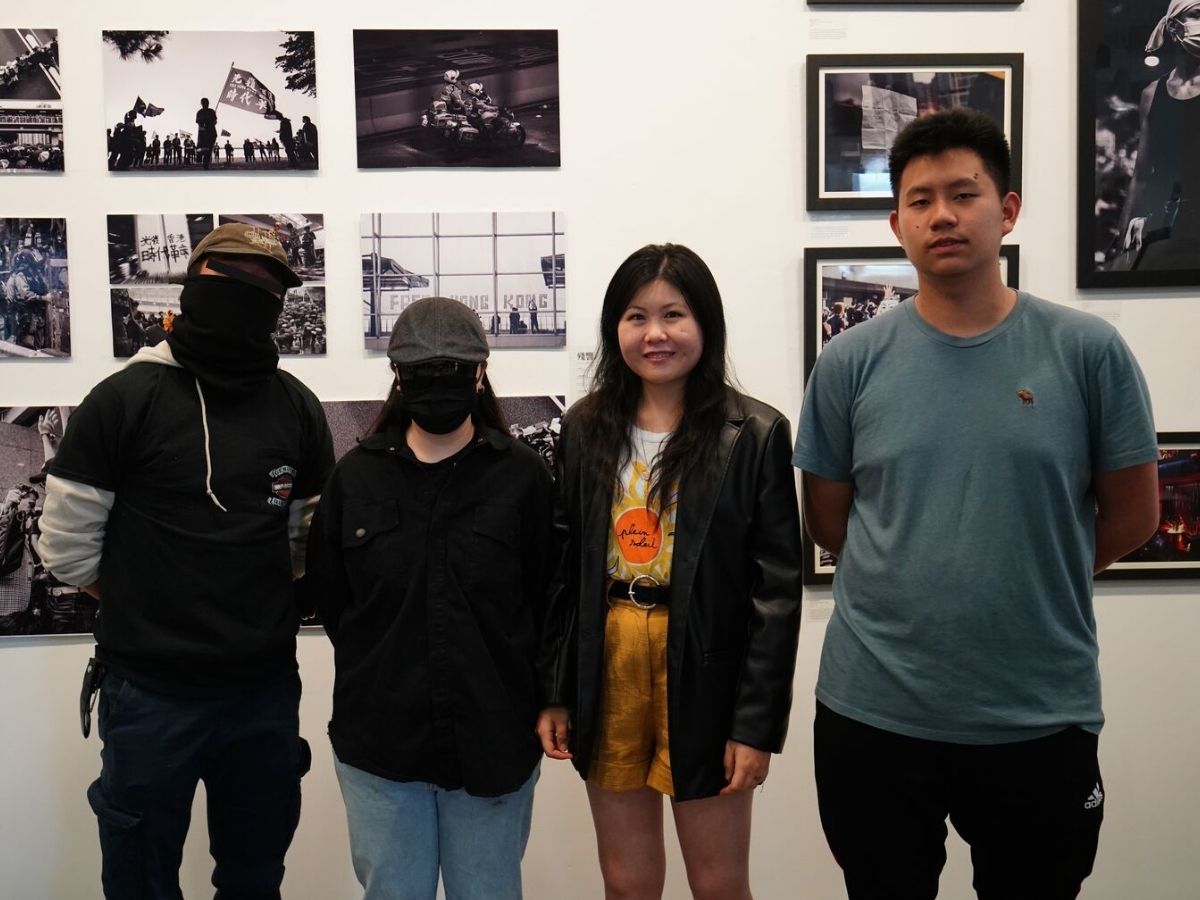
To understand the real fear many Hong Kong nationals experience when it comes to standing up to China, consider this: Two of the four photographers in a new Berkeley photography exhibit on Hong Kong’s pro-democracy movement refused to be photographed at the opening reception without covering their faces. And members of the UC Berkeley student organization that sponsored the event, Hong Kong Affairs Association of Berkeley, also demurred from identifying themselves.
Echoes of Defiance, Fourth Street Fine Art, 2000 4th St., through May 1
“We’re worried about using our names because we have to go back to Hong Kong,” one of the organizers told Berkeleyside.
The exhibition, “Echoes of Defiance,” which opened April 8 at Fourth Street Fine Art and runs through May 1, is the first overseas Hong Kong student photo exhibition on the 2019 pro-democracy movement, the organizers say. Its goal is to document the demonstrations sparked by a bill that would have allowed extraditions to mainland China and to showcase the resistance of ordinary citizens.
The images chosen show the solidarity of the protesters and put a more human face on the large-scale events that attracted hundreds of thousands between March and November 2019. Some of the images take place before or after those events, but add to the narrative of Hong Kong’s uneasy transition to mainland Chinese rule.
At the Hong Kong airport, Michael Ho, who documented the 2019 demonstrations when he was only 15, photographed residents saying goodbye to loved ones on July 17, 2021, before moving to Britain.
A different photographer, who uses the name Mo, captured colorful seas of umbrellas and hard hats worn as protection during the demonstrations, joyful and graphic images that contrast with the seriousness of the events taking place. Mo came to the U.S. as a graduate film student and returned to document the protests. He went from being an observer to a participant after witnessing police brutality. He’s now in exile and seeking asylum in the U.S.
“I felt an obligation to capture the historical moments because the government can use their propaganda to brainwash people and say it never happened,” said a photographer who goes as Kong. “Photos are evidence of our experience, our horror. Our sorrow. I wanted to be a capturer, to capture what was actually happening.”
The photographers are all under 25, Hong Kong-born and living in the Bay Area. One is a student at UC Berkeley. At the opening reception on Saturday they talked about the importance and the danger of carrying a camera.
“The environment was pretty complex,” said Kong, who has participated in student movements in Hong Kong since 2012. “You are always panicky, not knowing where to go next, if the police are going to shoot at you or not.”
She pointed to one of her images showing a human chain of citizens linked arm-in-arm and described their bravery. “People on the front line were very brave. They were the first to get shot.”
Photographer Katherine Li said protesters compared their treatment to that of George Floyd.
“People were saying they couldn’t breathe because of the tear gas and the way police were holding them,” she said. “I saw a lot of bloodshed involving the police.” One of her friends was beaten up badly, requiring seven stitches on his upper lip.
The images in the exhibition depict little of the violence. Those grisly scenes have been well publicized, organizers said, and the goal of the exhibit is to “illuminate stories and ideas that go beyond mainstream media coverage.”
Carrying a camera proved dangerous as journalists were often targeted, except for those with foreign press credentials, like Li, who worked as an intern for The New York Times’ Hong Kong bureau when the demonstrations started. Li studied journalism as an undergraduate and is now a first-year student at UC Berkeley’s Graduate School of Journalism.
“They were a little more careful if you are a foreign reporter,” Li said. “I was protected by my badge.”
Richard Koci Hernandez, an associate professor at the School of Journalism and a photographer himself, called the work of the photojournalists brave.
“When you, as a photojournalist, enter a protest, you become extremely vulnerable on many levels. As the histories of protests have shown, many calm beginnings have had tragic endings,” he said. “When you’re in the center of the action doing your best as a camera and eye will do to record the truth, it’s one of the bravest things a photojournalist can do.”
Mo noted how most of the protesters were young — many of them teenagers. For him, the image he took of a youth holding a Captain America shield symbolizes the bravery exhibited by the youth.
“Even though the police are arresting all the protesters, what’s more important is what the protesters believe,” Mo said. “Ideas are invincible and bulletproof, no matter how much tear gas and bullets they shoot at us. We will never give up.”
Still, the fact that these young photographers are, in their own way, standing up against forces of authoritarianism in China leaves their relationship to their homeland unclear.
“I love Hong Kong and just want to live there,” said Ho, whose work has appeared in the Guardian, CNN, the Hong Kong Free Press and NBC News. He’s now 17, living in Alameda with a sister who’s a U.S. citizen, enrolled in high school and trying to get a green card.
“Maybe one day I will go back. Who knows what will happen in the future.”
The exhibit is sponsored by the Hong Kong Affairs Association of Berkeley, a group founded in 2019 and made up of 10 UC Berkeley students looking to raise awareness of issues related to human rights and democracy in Hong Kong.
Fourth Street Fine Art, 2000 Fourth St., Berkeley. Phone: 510-647-8136. Hours: Friday-Sunday, noon-5 p.m. Connect via Facebook and Instagram. Through May 1.
